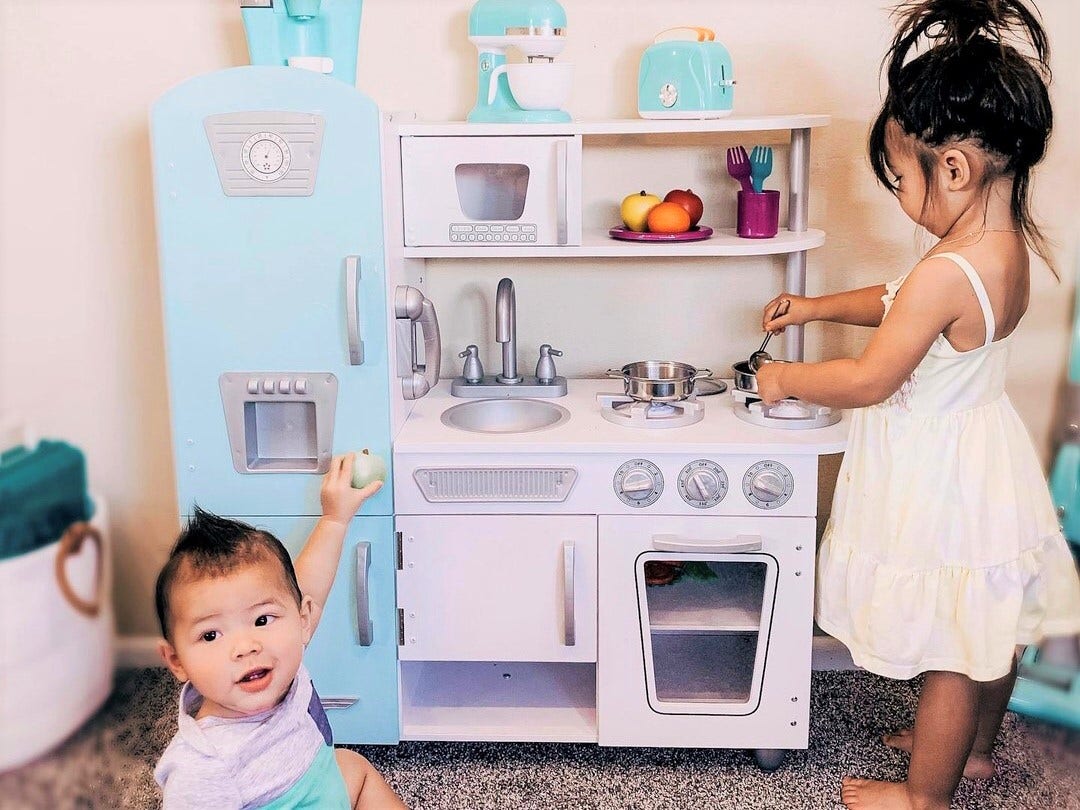
Activities That Promote Sharing
Sharing doesn’t come naturally for toddlers. Putting aside their own desires and prioritizing someone else’s requires a level of cognitive development that most kids won’t fully reach until age 3.5 to 4. But that doesn’t mean we can’t help our kids progress toward sharing and taking turns before that. The sooner we start setting expectations, encouraging sharing, and helping them process big emotions when they don’t want to share, the more likely they’ll be able to share easily and happily as they get older.
Here are a few tips adults can use to help toddlers and preschoolers share with their siblings and peers – plus a few activities that make sharing fun for even the most close-fisted kiddos.
Think “Long Turns” instead of “Share Right Away”
Your three-year-old picks up a toy, and your eighteen-month-old immediately toddles over to grab it. Your three-year-old shrieks, the baby cries, and you remind the older child to share with their sibling. Sound familiar?
While this approach to sharing may seem easy to us, for younger kids, it feels unfair and even baffling. And when you really think about it, even you wouldn’t take kindly to someone wanting an item you’d just begun to use. In these cases, it’s best to let the first child who had the toy play with it until they’re finished. Once they’ve left the toy behind, the other child can take their own long turn – no snatching allowed from either kid.
This approach to sharing is more in line with toddler and preschooler’s cognitive development. “I can’t snatch something someone else has” is much easier to comprehend than “I must give up the thing I have because someone else wants it.”
Help Kids Wait Their Turn
Of course, this approach is tough for the child who has to wait their turn. You can help by acknowledging and validating their feelings (i.e. “It’s okay to be upset. Waiting is hard.) and helping them find other ways to play as they wait. Sometimes a little distraction is key to preventing a meltdown.
Praise Spontaneous Sharing and Point Out The Positive Consequences
Okay, so we get that the “turn-taking” scenario isn’t *exactly* sharing. So when kids do share all on their own, make sure you encourage the behavior with praise (just don’t overdo it) and point out how happy they’ve made their sibling or friend. Doing so will help your child want to share more as they get older. Sharing becomes something they can be proud of and feel good about instead of something adults force them to do.
Fun Activities that Promote Sharing
To make sharing even more attractive, try out games and activities that make sharing fun!
Basketball, Soccer, and Other Team Sports
The toddler version that is! All the technical rules are too much for toddlers to understand, but working towards a common goal of passing the ball to each other and getting in the hoop or goal? That they can handle. The more they toss or kick the ball to their peers, the more you cheer!
Hot Potato/ Pass the Ball
Hot potato is all about not keeping the ball, so it’s great for kids who struggle to give up objects to their friends. If your little ones are too young to understand hot potato, try a simple game of rolling and passing the ball back and forth. Make passes quick and silly to make it seem more fun!
Pretend Sharing
Even if your kid doesn’t love to share, they’re probably totally fine with their dolls, stuffed animals, and other toys sharing with each other. As you play pretend with your child, you can make up scenarios where both dolls want a turn in the elevator dollhouse or both trains want to go through the tunnel. You can act out the situation together… and of course, you’ll make sure the toys showcase sharing as fun and easy!
Roleplay Sharing
Similarly, your child might be more willing to share if they’re pretending to be a character rather than themselves. For example, they can be the head chef in their play kitchen who needs to share the tools and food with you, their assistant.
Learning to share will take plenty of time and patience from both your child and you! We hope these tips and activities can make that process a little less tear-filled and a lot more fun!

